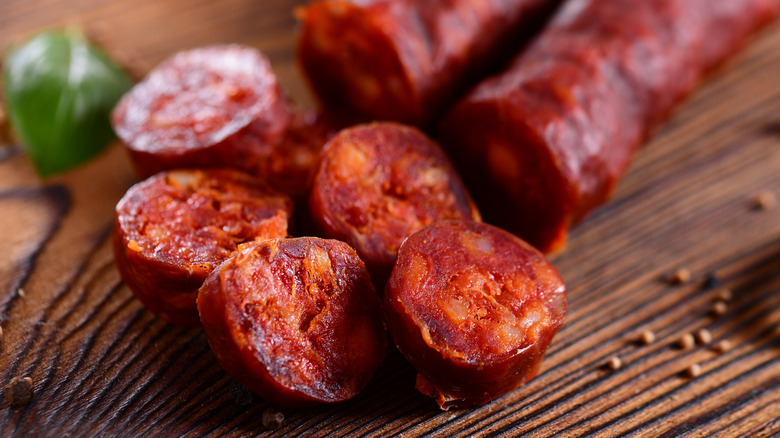What's The Difference Between Mexican And Spanish Chorizo?
Imagine you are cooking potato chorizo taquitos for a group of friends, and one of them casually asks (albeit a tad smugly) if the recipe calls for Mexican or Spanish chorizo. In this particular recipe, you can infer that it is the former given that it is a Mexican-inspired dish, but some do not specify which version to use. Does that mean they are interchangeable?
The short answer is no, because there are notable differences between Mexican and Spanish chorizo. The longer answer is that Mexican and Spanish chorizo are made with different ingredients and processes and are used differently in cooking. By understanding these details, you can make your own call about which version to use in recipes — or play the "which type of chorizo do you reckon this is" game with your mates when you dine out.
Mexican chorizo is always cooked before serving
The core ingredients for both Mexican and Spanish chorizo are pork, although there are instances where other proteins are used). But this is where the similarity ends. Mexican chorizo is shorter and stumpier looking and made with fresh (i.e. raw) or uncooked ground pork. Spanish chorizo is longer, uses chopped meat, and — very importantly — is cured, similar to a salami. This means you need to cook the Mexican chorizo links before eating it. The meat can also be removed from the casing and used in place of ground pork for chili or burgers. In comparison, the Spanish chorizo can be sliced and eaten as-is — there is no cooking required.
The spices that flavor both sausages are also different despite the similar red-brown hues. As a general rule, Mexican chorizo is seasoned with vinegar, chile peppers, cumin, oregano, and garlic — though this depends on the region. This makes it spicier than the Spanish version. The main flavor profile for Spanish chorizo comes from a specific type of paprika known as pimenton, which gives it its signature red color, as well as either a sweet or spicy taste that varies by region. It also has a smokier flavor compared to the Mexican version.
The best chorizo choice depends on how you want to eat it
The easiest way to eat chorizo is to use the Spanish version in a meat-and-cheese platter or as part of a tapas meal, since there is no prep required. This is absolutely not the time and place to use the Mexican version because you will simply be eating raw ground meat.
If you are new to chorizo and want an easy way to cook it, it helps to think of it as a "spicy" sausage and use it in a standard eggs and sausage breakfast. In this instance, you can cook both Mexican and Spanish chorizo. The flavor of the Spanish sausage will change slightly after it is cooked because the outside will be crispy and crunchy with a soft but firm inside.
The reality is chorizo works best in hearty Latin American, Spanish, and Portuguese recipes like a Mexican lentil stew or a Spanish bean soup. Just don't include chorizo in paella because when Jamie Oliver did it, he incurred the wrath of Spanish people for this blasphemy.


